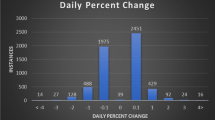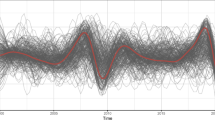Abstract
This study generates nowcasts and forecasts for the growth rate of the gross domestic product in Turkey using 204 daily financial series with mixed data sampling (MIDAS) framework. The daily financial series include commodity prices, equity indices, exchange rates, and global and domestic corporate risk series. Forecasting exercises are also carried out with the daily factors extracted from separate financial data classes and from the whole dataset. The findings of the study suggest that MIDAS regression models and forecast combinations provide advantage in exploiting information from daily financial data compared to the models using simple aggregation schemes. In addition, incorporating daily financial data into the analysis improves the forecasts substantially. These results indicate that both the information content of the financial data and the flexible data-driven weighting scheme of MIDAS regressions play an essential role in forecasting the future state of the Turkish economy.
Similar content being viewed by others
Notes
Almon distributed lag polynomial has delivered the best results for the Turkish economy. Results with other polynomial functions are available upon request.
The first factor estimator builds upon the one-sided nonparametric dynamic PCA. Second, the expectation-maximization (EM) algorithm is combined with the factor estimator-based static PCA as introduced by Stock and Watson (2002). The third one is the two-step parametric state-space factor estimator.
Another term used in the forecasting literature is backcasting which refers to making forecasts for a certain period using data that become available after that certain period ends. This is usually the case for quarterly GDP growth forecasts with monthly data where GDP growth is announced with approximately 3 months lag, while monthly data become available with one or 2 months lags.
For an overview of the forecast combination literature, please see Timmermann (2006).
We have received best results from this combination method.
The initial regression shows that this combination of the parameters delivers the best performance in our case.
The selection of the series is solely based on the data availability.
We carry out the HLN and CW tests with all financial data classes and comparison dimensions (e.g., ADL vs. ADL-MIDAS models); however, only for the whole sample test results are reported here for space considerations. Other test results are available upon request.
In addition to HLN and CW tests, robustness of the results is checked with forecast encompassing and mean squared adjusted test statistics (Clark and McCracken 2001, 2010; McCracken 2007) when the bigger model includes additional variables. The details of the tests are given in Appendix of the working paper version of this study (Şen Doğan and Midiliç 2016). We have significant results similar to the ones in the working paper version. The test results for the forecast results reported in this version are available upon request.
References
Aiolfi M, Timmermann A (2006) Persistence in forecasting performance and conditional combination strategies. J Econ 135(1):31–53
Akkoyun HC, Günay M (2012) Nowcasting Turkish GDP growth. CBRT Working Paper (No: 12/33)
Andreou E, Ghysels E, Kourtellos A (2011) Forecasting with mixed-frequency data. In: Oxford handbook of economic forecasting, pp 225–245
Andreou E, Ghysels E, Kourtellos A (2013) Should macroeconomic forecasters use daily financial data and how? J Bus Econ Stat 31(2):240–251
Armesto MT, Hernandez-Murillo R, Owyang MT, Piger J (2009) Measuring the information content of the beige book: a mixed data sampling approach. J Money Credit Bank 41(1):35–55
Bai J, Ghysels E, Wright JH (2013) State space models and MIDAS regressions. Econ Rev 32(7):779–813
Bates JM, Granger CW (1969) The combination of forecasts. Or 20(4):451–468
CBRT (2015) Inflation report-3
Clark TE, McCracken MW (2001) Tests of equal forecast accuracy and encompassing for nested models. J Econ 105(1):85–110
Clark TE, McCracken MW (2010) Testing for unconditional predictive ability. Federal Reserve Bank of St. Louis Working Paper (No: 2010-031A)
Clark TE, West KD (2007) Approximately normal tests for equal predictive accuracy in nested models. J Econ 138(1):291–311
Clements MP, Galvão AB (2008) Macroeconomic forecasting with mixed-frequency data: forecasting output growth in the United States. J Bus Econ Stat 26(4):546–554
Clements MP, Galvão AB (2009) Forecasting US output growth using leading indicators: an appraisal using MIDAS models. J Appl Econ 24(7):1187–1206
Diebold FX, Mariano RS (1995) Comparing predictive accuracy. J Bus Econ Stat 13(3):253–63
Elliott G, Gargano A, Timmermann A (2015) Complete subset regressions with large-dimensional sets of predictors. J Econ Dyn Control 54:86–110
Foroni C, Marcellino M (2013) A survey of econometric methods for mixed-frequency data. Norges Bank Working Paper Series (No: 2013-06)
Galvão AB (2013) Changes in predictive ability with mixed frequency data. Int J Forecast 29(3):395–410
Ghysels E, Wright JH (2009) Forecasting professional forecasters. J Bus Econ Stat 27(4):504–516
Ghysels E, Santa-Clara P, Valkanov R (2004) The MIDAS touch: mixed data sampling regression models. CIRANO Working Papers (No: 2014s-20)
Gros D, Selçuki C (2013) The changing structure of turkey’s trade and industrial competitiveness: implications for the EU. Centre for European Policy Studies (CEPS) Working Paper Series (No: 03)
Hamilton JD (2008) Daily monetary policy shocks and new home sales. J Monet Econ 55(7):1171–1190
Harvey D, Leybourne S, Newbold P (1997) Testing the equality of prediction mean squared errors. Int J Forecast 13(2):281–291
Hendry DF, Clements MP (2004) Pooling of forecasts. Econ J 7(1):1–31
Kuzin V, Marcellino M, Schumacher C (2011) MIDAS vs. mixed-frequency VAR: nowcasting GDP in the euro area. Int J Forecast 27(2):529–542
Marcellino M (1999) Some consequences of temporal aggregation in empirical analysis. J Bus Econ Stat 17(1):129–136
Marcellino M (2008) A linear benchmark for forecasting GDP growth and inflation? J Forecast 27(4):305–340
Marcellino M, Schumacher C (2010) Factor MIDAS for nowcasting and forecasting with ragged-edge data: a model comparison for German GDP. Oxford Bull Econ Stat 72(4):518–550
Marcellino M, Stock JH, Watson MW (2006) A comparison of direct and iterated multistep AR methods for forecasting macroeconomic time series. J Econ 135(1):499–526
McCracken MW (2007) Asymptotics for out of sample tests of Granger causality. J Econ 140(2):719–752
Monteforte L, Moretti G (2013) Real-time forecasts of inflation: the role of financial variables. J Forecast 32(1):51–61
Sacakli-Sacildi I (2015) Do BVAR models forecast Turkish GDP better than UVAR models? Br J Econ Manag Trade 7(4):259–268
Schumacher C, Breitung J (2008) Real-time forecasting of German GDP based on a large factor model with monthly and quarterly data. Int J Forecast 24(3):386–398
Şen Doğan B, Midiliç M (2016) Forecasting Turkish real GDP growth in a data rich environment. CBRT Working Paper (No: 16/11)
Stock JH, Watson MW (2002) Forecasting using principal components from a large number of predictors. J Am Stat Assoc 97(460):1167–1179
Stock JH, Watson MW (2003) Forecasting output and inflation: the role of asset prices. J Econ Lit 41:788–829
Stock JH, Watson MW (2004) Combination forecasts of output growth in a seven-country data set. J Forecast 23(6):405–430
Tay AS (2007) Financial variables as predictors of real output growth. Singapore Management University, School of Economics Working Papers (No:7-2007)
Timmermann A (2006) Forecast combinations. Handb Econ Forecast 1:135–196
Wohlrabe K (2009) Forecasting with mixed-frequency time series models. PhD thesis, Ludwig-Maximilians-Universität München
Acknowledgements
Authors thank the editor and two anonymous referees of the journal, Koen Inghelbrecht and Gert Peersman, for valuable comments and suggestions.
Author information
Authors and Affiliations
Corresponding author
Rights and permissions
About this article
Cite this article
Şen Doğan, B., Midiliç, M. Forecasting Turkish real GDP growth in a data-rich environment. Empir Econ 56, 367–395 (2019). https://doi.org/10.1007/s00181-017-1357-8
Received:
Accepted:
Published:
Issue Date:
DOI: https://doi.org/10.1007/s00181-017-1357-8




